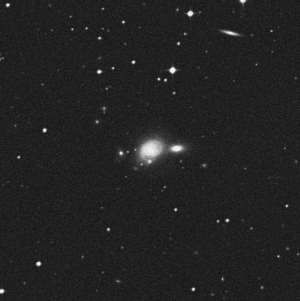
2010
Saturday,
December 11
It is
incredible that we had so many fine days this month. This was the
seventh comet hunting sessions in December, though I have only a few
days in usual year. This month last year, I had no comet searching
sessions.
I
began to sweep the sky at 3:45a.m. from Gamma Corvi. I identified 21
deep sky objects but it took more time to search than usual for some
reasons.
Firstly,
some of the galaxies that came into the view looked brighter than the
data shown by the NGC Sky Vector, e.g. NGC4272 seemed to be 11th
magnitude, but the device said it was 13th magnitude. I had
to accept the data at the site since I confirmed the position using
Uranometria 2000. Now I learned NGC4727 has a companion, NGC4724, and
a star with a magnitude of 9.9 is on this companion that made NGC4727
brighter apparently. There were some other galaxies whose
appearances, especially magnitudes, did not coincide with
the data this predawn, and it puzzled me. I though the zodiacal light
affected the apparent magnitude and the appearance of DSOs.
Secondary,
the digital setting circles did not work well and I set it up again
during the session. Later I noticed that the screw bolt for the
altitude encoder did not tighten enough and I tightened it to set up
the DSC again.
Thirdly,
seeing was bad at first that distracted me.

NGC4727
(center). A companion, NGC4274, is on the right of 4727, on which a
star with a magnitude of 9.9 is imposed but not recognized in this
photo. The image is 10f wide.
The Digitized Sky Survey copyright©1994
As a
result, I overlooked many bright galaxies while identified some dark
ones. The area I swept was smaller than that of a typical hunting
session. Even thought the sky was clear I felt frustrated with this
session.
The bonus was that I could observe P/2010 V1
Ikeya-Murakami with a magnification of 255 using Ethos 8 mm. As posted
on gComet observationh
page the magnitude was 14.5 with a diameter of 0.6f. This might be the
last observation of the comet this time, though it will return in 5
years.
Thursday, December 2
Nearly
one month has passed since my discovery of P/2010 V1 Ikeya-Murakami. The
comet has faded down to 12th magnitude but I was lucky enough to observe
it at this predawn even under the condition of moonlight. The comet,
near Venus as shown on the chart below, was apparent with a
magnification of 157x but difficult with 78x. At a moonless night the
comet must be much easy to observe. In addition to Venus, Saturn, Spica
and the crescent moon decorated the predawn sky gracefully.

I had
conducted comet-hunting sessions seven times last month, and this was
the third session, i.e. two at predawn and one at dusk, this month. I
began to search from the constellation of Crater at 3:40a.m. and reached
near Venus at 5:43a.m. when I finished hunting. I identified 10 deep sky
objects including M68 and M104. I overlooked some galaxies brighter than
11th magnitude due probably to moonlight and oversight.
Last year I
had no comet-hunting sessions in December because of adverse weather,
but we have not had snow yet this winter in my city. I think I can
comet-hunt a few more times this month as good weather is expected.
Tuesday,
October 19
It has been
cloudy during nights for nearly two weeks, but last dusk the forecast
predicted clear sky throughout the night. I believed the prediction and
decided to visit a high altitude observing site where it takes one hour
by car from my house.
On Monday, I
arrived at the site before 9a.m. and set up my comet-seeker. The cloud
covered 90% of the sky but I enjoyed moon and Jupiter watching for half
an hour through the cloud or when they appeared from the gap of the
cloud. At 9:30 I fell asleep in my car.
I got up at
2a.m. at the time of moonset, but it was overcast. At 2:30 there
appeared some gaps among the cloud, and instead of starting comet
hunting session, first of all I tried to observe Barnard Loop in Orion
using H-Beta filter by naked eye. I have ever confirmed the nebula in
this way, and I could recognize Barnard Loop again with a direct vision!
Unexpectedly, I also noticed the HII regions of Horse Head Nebula and
Sharpless 2-264 located around Lambda Orionis, though the transparency
was less than normal. I made a sketch of these nebulae as shown below.
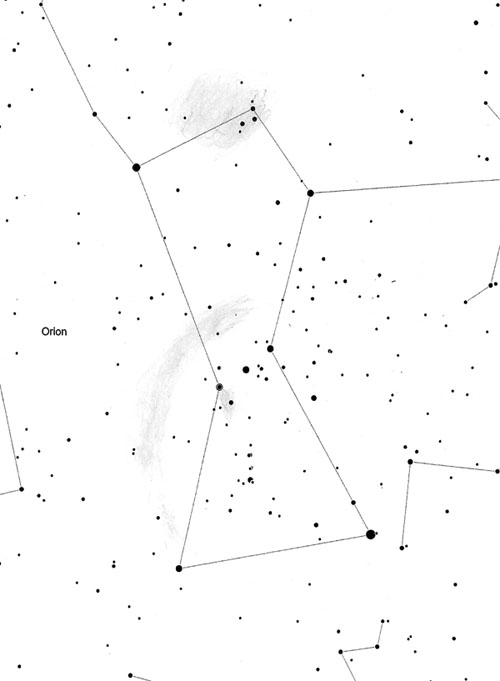
Barnard
Loop, HII regions of Horse Head Nebula and Sharpless 2-264. H-Beta
filter with naked eye.
California Nebula was also very clear at a glance, though I did not
remember the location prior to the observation. A few minutes later, all
the sky was covered with thin cloud.
I managed to comet hunt till 4:40a.m. The cloud always covered over 80%
of the sky, and many times I was forced to stop searching. When my
comet-seeker was trained at Leo, the International Space Station passed
near Legulus. This time I saw the main unit was sandwiched between a
pair of solar battery panels with 78x. The whole unit was dazzling gold!
Sunday, October 3
Prior
to the comet hunting session, I observed 103P Hartley 2. It looked
bright and large with a wide tail even under the moonlight.
I wanted to
search the constellation of Leo, because many comets had been discovered
in this constellation in October as Tsutomu Seki described in his books.
I myself spotted a new comet on October 4 in 2006, but several hours
before my report the comet had already been announced as C/2006 T1 Levy!
Unfortunately,
Leo was covered with the cloud. Instead of sweeping there I started
searching from Canis Major at 2:50a.m. Seeing was very bad and at an
altitude of less than 10 degrees star image swelled as large as apparent
diameter of Jupiter! At 3:20a.m. the amount of cloud reduced and Leofs
head appeared. I trained my comet-seeker at Regulus, alpha Leonis, and
began searching this constellation. Seeing got better as time went.
Suddenly, a galaxy with a hint of spiral structure came into the field
of view (FOV). I recognized it as NGC2903 from the appearance. At
4:25a.m. during the twilight, I spotted a faint comet like object. I
guessed that it was a galaxy judging from the elongated shape. At the
next moment I noticed another galaxy near the first one. The NGC Max
identified them as NGC2964 and 2968, respectively. Both were 11th
magnitude.
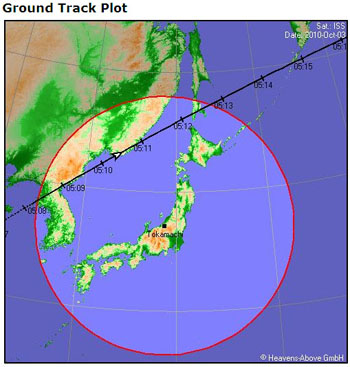
International
Space Station around 5:10a.m. on October 3
The session was completed at 4:45, and after that I tested how Paracorr
and my new eyeglasses work (see below). When I tried to take down my
telescope, a dazzling satellite appeared in the NW. I aimed my
comet-seeker at the satellite, and as I thought it, turned out to be the
International Space Station. It looked H shaped due to a pair of solar
panels!
About new eyeglasses and Paracorr
Last week I renewed my eyeglasses. I used the old ones for four years,
but it did not fit my eyes before I knew it. The new one includes
astigmatism correction, though the old one did not. My astigmatism was
weak, however, when it comes to observing stars with naked eyes (of
course, with eyeglasses), astigmatism correction works effectively and
it have opened a new world.
When I peer into the telescope my new eyeglasses improve the star image
slightly; astigmatism is corrected. But it is not very drastic as my
astigmatism is only 0.25 diopter (the weakest). Whether I wear my
eyeglasses in looking at the comet-seeker or not is dependent on the
condition. I do not, if moonlight or city light is reflected my glasses
or my breath condenses on the glasses. Without eyeglasses apparent FOV
looks larger and when I want to enjoy this effect I get my glasses off.
Relevant to my eyeglasses, I decided to change my optical system of my
comet-seeker. I own Paracorr, a coma corrector of TeleVue, but I did not
employ it for usual hunting sessions, as it extends the focal length of
the primary mirror by 15%. This means that the FOV is reduced by 15%,
from 1.3 degrees (68x) to 1.1 degrees (78x) using Planocular 30 mm 88
degrees eyepiece of Leitz.
However, using Paracorr makes the star image pinpoint almost all over
the FOV and I can concentrate on the searching activity. From now on, I
will always use Paracorr for every comet hunting session, by which I
feel like as if I had introduced a new instrument.
Friday, September 17
Last
dusk the forecast predicted that it would be rainy throughout the night.
I had no intention of comet hunting at the coming predawn at that time,
and I went to bed late, before 11p.m.
Suddenly, I
woke up at 3a.m. at this predawn, unexpectedly. I felt it must be fine.
I got up and looked up the sky through the window, and it actually was!
I decided to
comet search and went to out. The ground surface was wet. Cloud covered
some 50% of the sky, but it was crystal clear with the gorgeous winter
constellations. I started the comet hunting session at 3:35a.m. from
about 20 degrees the west of Procyon, Alpha Canis Minoris. Even though
cloud passed away the searching area from time to time, the winter Milky
Way in Monoceros was a breathtaking vista!
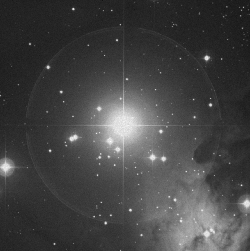
A part of NGC2264 and 15 Monoterotis. The image is 15f wide.
The Digitized Sky Survey copyright©1994
I noticed a nebulous object was imposed on a bright star, which looked
scattered light of the star by thin cloud at a glance. Actually, thin
cloud covered the star, but I confirmed that the scatter did not occur
at the other bright stars and concluded that there was the nebulous
object on it. The NGC-Max told me it was NGC2264, Christmas Tree nebula,
and it turned out that the bright star was 15 Monocerotis with a
magnitude of 4.7.

Leo and Mercury above the horizon at 4:30a.m.
Produced by MegaStar ver.5.
After the beginning of the twilight, I was impressed by the greatness of
Leo whose head rose from the eastern horizon. When did I watch this
constellation last time?
The amount of cloud increased with time, and a bright star rose just
above the eastern horizon when I completed the session at 4:30a.m. The
object looked non-stellar with an apparent diameter of around 10". I
identified it as Mercury at home.
While I was taking down my 46 cm comet-seeker it began to rain, but it
was weak and I had no trouble. What a happy hunting session!
Sunday, September 5
Clear
sky! When I drove to the observing site, Orion rose from the horizon
that looked great.
I began to
search at 2:15a.m. from the constellation of Eridanus under a moonlit
condition. In a few minutes, I identified NGC 1432, an 11th magnitude
galaxy in Eridanus. I wondered if I could spot any galaxies in this
constellation as all of them are dark, but I was satisfied with
identifying one.
After M79
passing through the FOV, I noticed another faint galaxy in Lepus,
NGC1832. This galaxy is located at 35f NNE of Mu Leporis, a 3third
magnitude star. These two objects were in the same FOV. There are
several galaxies 11th magnitude or brighter in the search area, which
can be spotted during the hunting session, but I could not.
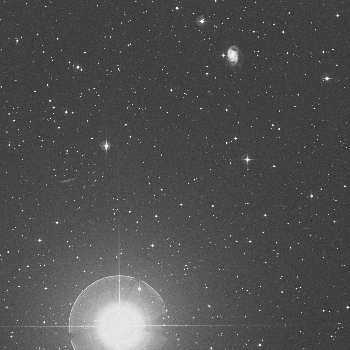
NGC1832
(upper right) and Mu Leporis (lower left). The image is 40f wide.
The Digitized Sky Survey copyright©1994

NGC1788. The image is 10f wide.
The Digitized Sky Survey copyright©1994
The other impressive object was a reflection nebula, NGC1788, in Orion.
The apparent size is 5.5fx3f with an irregular shape. Even under the
moonlight, the shape of the nebula was obvious.
Usually, I do not care the color of a bright star to keep dark
adaptation, but this predawn I peered at Rigel. It looked pure white and
beautiful! I wanted to do so because seeing was very good. When I
reached M42, I changed the eyepiece from Planocular 30 mm to Ethos 13
mm. Trapezium E and F were steadily seen thanks to the good seeing.
At 4:20a.m. I completed a long comet hunting session with satisfaction.
Sunday, August 22
I
enjoyed comet hunting sessions three days in a row! Obviously, the
weather pattern had changed and we have few cloudy nights.
However, I
had a hard time with my lower-back pain caused by fatigue due to a heat
wave. I could manage to set up my 46 cm comet-seeker on Friday, but on
Saturday I employed Hawaii telescope (30 cm telescope) to avoid burden
on my lower-back. This predawn, I used 46 cm again since my lower-back
pain was getting better.
I began to
search from M1 at 2:25a.m. I knew there are few comets like objects in
this region. M37 was high in the sky and looked very beautiful. The
other Messier objects in the same constellation, Auriga, M36 and 38 did
not come into the FOV because they were too high in the sky and were out
of the search area. M35 and accompanied open cluster NGC2158 looked
crisp.
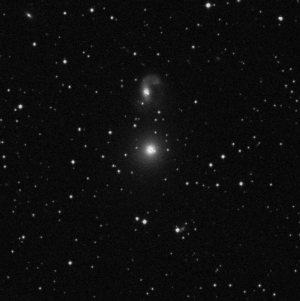
NGC2274 (center) and NGC2275 (north of NGC2274). The latter was not
visible with my comet-seeker. The image is 10f wide.
The Digitized Sky Survey copyright©1994
At 3:40a.m., some 10 minutes after the start of the twilight, I
identified a faint galaxy NGC2274 with 12th magnitude.
Before taking down the comet-seeker, I trained the telescope at Jupiter.
Seeing was incredibly nice and the image of the Giant planet was superb!
I do not comet hunt for a week from tomorrow because of the moonlight.
Saturday, August 7
Last
night at 10p.m. it was starry sky and I got up at 1a.m. this predawn
with the hope of clear sky. But as forecasted it was overcast.
Actually, it
has been fine and hot in daytime with cloudy and rainy in nighttime for
a couple of weeks. On Thursday air temperature reached nearly 36 degrees
Celsius and at Friday predawn we had more than 90 mm of rainfall for
about three hours. This pattern of weather has been repeated day in and
day out and I have no chance for comet hunting. The situation is the
same today and tomorrow.
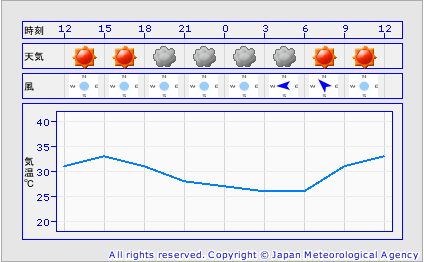
Forecast for August 7-8 2010
I live here
in a heavy snowfall area, but I cannot say that I have fewer
opportunities for comet hunting in winter as shown below. I can say that
I live in an area with a smaller number of clear days throughout a year.
| @Year/Month |
Number of nights comet hunted@ |
| @2009 |
@ |
| @ December |
0@ |
| @2010 | @ |
| @ January |
3 |
| @ February |
3 |
| @ March |
1 |
| @ April |
4 |
| @ May |
4 |
| @ June |
5 |
| @ July |
4 |
Monday, July 19
Clear sky
two consecutive predawns!
Prior to the
hunting session, I observed 10P Tempel. The comet was bright and large
with a wide tail that looked V shaped. I wondered if the comet had two
tails.
I began to
search from M77 that was the last galaxy I spotted yesterday. The sky
was as crisp as yesterday, and I identified four galaxies with 11th and
12th magnitude in total.
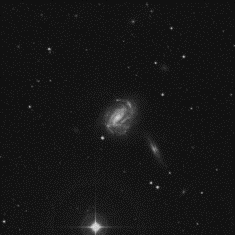
NGC877
(spiral galaxy) with a companion NGC876 that was not visible with my 46
cm comet-seeker. The image is 10f wide.
The Digitized Sky Survey copyright©1994
When I
spotted one of the 11th magnitude galaxies NGC877, I noticed a hint of
spiral structure with 67x. As shown in the photo (DSS), it actually has
the structure. Under the superb sky condition, I sometimes notice such a
structure. It is a joy!
Sunday, July 18
It was extremely humid and we had severe thunderstorm at dusk
yesterday. After the storm, we saw a beautiful rainbow. The rainy season
had ended!

A wonderful rainbow after the thunderstorm. Photo was taken from the
window of my room using 15 mm fish-eye lens.
The Japan Meteorology Agency announced that the rainy season seemed to
have finished yesterday. They do not clearly state the end because there
is no objective standard to judge the end or the start of the rainy
season. Anyway, I expected a clear sky this predawn and it actually was.
I began to sweep the southeastern sky at 2:05a.m. In one minute a pair
of galaxies with 11th magnitude came into the FOV; NGC470 and 474 in
Pisces. Another one minute later, I spotted NGC 779, an 11th magnitude
galaxy in Cetus. The faintest one was NGC706 with a magnitude of 12.5
but I was happy to identified 12th magnitude one, NGC955, at an altitude
of 20 degrees, as this implied that I have a potential to discover a
faint comet of 12th magnitude at a low altitude.
Thanks to excellent transparency after the storm, there was no haze at
all and I finally identified 10 faint galaxies. Even so, I must miss
some galaxies with 11 to 12 mag.
It really was a comfortable and satisfactory hunting session!
Sunday, July 11
Now that we have
rainy season in Japan, we cannot expect clear sky at least for a few
weeks. I hope it will finish at the end of this month as usual.
The July
Issue of the Sky & Telescope magazine read many people in the US
witnessed a strange meteor on July 20th in 1760; Walt Whitmanfs gYear of
Meteorsh, pages 28-33. Actually, it was not a meteor but a comet that
intruded into the earthfs atmosphere! However, it had a velocity higher
than the escape one of our planet, so it got back into the space. How
exiting the phenomenon is!

The article
said similar events have ever occurred many times; in 1783, 1876, 1923
and 1972. For the last one a photo was taken.
I wonder if
it happens today the robotic surveys can detect it before the object
approaches the earth. Probably, not necessarily can. Chances are we
amateurs can do.
On the other
hand, the same issue states, gvisual comet discoveries are now a
virtually extinct speciesh, in an article entitled gDeep-Sky Discoveryh.
In the story the authors describe that Mr. Dave Jurasevich, an amateur
astronomer and he himself is a coauthor, discovered a new planetary
nebula using high-tech gadgets and that amateurs spot many novae and
supernovae in the same way. I think this is because the number of visual
comet hunters decreases while that of CCD or digital camera users is
increasing.
The winners
of the Edger Wilson Award in 2009 discovered C/2008 N1, Q1, Q2, C/2009
E1 and F6. C/2009 E1 and F6 could be discoverable by visual searching
since their CCD or digital camera magnitudes were 12.8 and 12.5,
respectively; visually, they were 1 or 2 magnitude brighter.
There was no
visual discovery for three consecutive years (2007-2009), but this year
Machholz discovered C/2010 F4! As Tsutomu Seki stated we had to face
with a difficulty at era. The important thing is you can believe what
you are doing or not.
I may stop
visual comet hunting if robotic surveys like Pan-STARRS discover all the
comets, but it would rarely happen. Instead, I might be transferred to
urban area that makes it difficult to keep hunting.
Statistics
of comet discoveries: Maik Meyer
http://www.comethunter.de/index.html
Pan-STARRS
http://pan-starrs.ifa.hawaii.edu/public/home.html
Thursday, June 24
I
got up at 0a.m. because my body sensor detected clear sky. It was too
early as the moonset was 2:04 a.m. I went back to my bed and got up at 1
a.m.
I drove to
the observing site and completed setting up my comet-seeker before 2a.m.
The sky was crystal clear! Prior to the comet hunting session, under the
moonlight, I tried to observe C/2009 R1 McNaught but the comet was very
low near the horizon and was hidden by a tree. I tried to another comet,
10P Temple. The comet was faint with a diameter of some 3f and DC=0. I
felt that I could manage to identify the image if I encounter this comet
while I am sweeping the sky. After that I began to comet searching.
After the
moonset, I stopped comet searching activity for a while and aimed my
comet-seeker at C/2009 R1 that rose above the tree again. It was
brighter than a week ago and the tail was more apparent, but the length
of the tail seemed to be the same. The coma of 10P looked surprisingly
brighter and larger in comparison with that of before the moonset,
around 6f with DC=3 by intuition. What a big difference in the
visibility! I have reacknowledged the effect of moonlight on visibility.
Light pollution has a similar negative influence on the faint objects
like comets and nebulae, and I am happy to live in rural area.
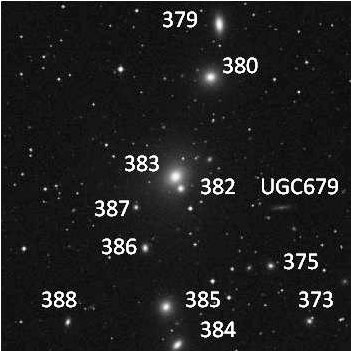
Galaxy group in Pisces, the bgirhtest is NGC383. The image is 15f wide.
The Digitized Sky Survey copyright©1994
The comet
hunting session was started from Gamma Pegasi, and I was expected to
identify M74 but I could not. Probably this was because of cloud that
passed near the galaxy. The first nebula I came across was NGC266, a
12th magnitude galaxy in Pisces. The second one was NGC380 in the same
constellation, but it forms a group. I could recognize two more galaxies
near this one. I tried to identify all and had a look at Uranometria
2000, butc
There were too many galaxies at the position on the map to identify! I
gave up checking all the three galaxies but I memorized the positions
relative to the stars to identify them later.
Then, a
large nebula-like image passed the western edge of the field. I moved
the telescope to introduce it to the center of the field. I found it M33
because of its spiral structure. The large nebula-like image was an edge
of the disk of M33; less than a quarter of the spiral disk from the edge
passed the FOV.
At home I
remembered the positions of the galaxy group and the stars around it. I
identified each of them using MegaStar5 and Digital Sky Survey and they
turned out to be NGC383, 373 and 385. All were 12th magnitude. NGC380
that was identified with the NGC MAX digital setting circle had not been
visible in the FOV actually.
I was satisfied with identifying four 12th magnitude galaxies under the
transparent sky, which probably I have observed for the first time.
Saturday, June 12
Contrary
to the last month, there are many fine days the former half of this
month. I got up at 1a.m. but the only star I could see was Altair. I got
back my bed and check the sky again at 1:30a.m. The part of the starry
sky was gradually expanded, but I hesitated to go comet hunting as the
gap of cloud occupied only less than 20% of the sky. Finally, I made a
decision to go, since I wanted to observe C/2009 R1 McNaught under the
moonless condition for the first time.
Luckily,
when I arrived at the observing site the amount of cloud reduced down to
60% of the sky. The eastern sky had been cloudy and even Jupiter could
not recognized by naked eyes. While I was assembling my comet-seeker,
however, cloud disappeared completely, though transparency was not so
good.
C/2009 R1
was bright with a tail of some 0.3 degrees. I observed the comet through
Comet Filter (Lumicon) but the appearance was unchanged. I expected the
detail of the coma or the tail could be observed but these situations
were the same with those of Sunday under the moonlight, partly because
of lower altitude of the comet and poor transparency of this predawn.
Then, I
could comet hunt only for 25 minutes, because cloud began to cover the
sky again. In 10 minutes it was completely cloudy and I was forced to
stop sweeping.
Jupiter that
sometimes appeared through the cloud still had a single belt.
Monday, May 31
At
last I could comet hunt at dusk before the moonrise, though it has been
cold and cloudy for more than a week. Farmers were worried about the
cold weather that affected the growth of agricultural product
negatively. Anyway, it was fine today and it would be so for a coming
week if the forecast is right.
Prior to the
session I observed C/2009 K5 McNaught and 81P Wild. C/2009 K5 was steady
and bright with a wide tail, but 81P was faint and I felt it was
difficult to spot the image while I was sweeping my 46 cm comet-seeker
with 68x. It was some 12th magnitude and slightly darker than NGC5427
near the comet.

NGC2683. The image is 15f wide.
The Digitized Sky Survey copyright©1994
I began to
search from Castor, Alpha Geminorum. It has been somewhat boring since I
encountered no DSOs for around half an hour. The first nebula that
passed the FOV was an edge-on galaxy NGC2683 in Lynx. The elongated
shape was beautiful. At 9:30p.m. I aimed the telescope at Leo as cloud
covered the searching area, and after that several galaxies came across
the FOV.
I completed
the session at 10:05p.m. a quarter later the moonrise. Before taking
down my comet-seeker I enjoyed observation of M57 and M13. Both were
impressive even under the moonlight!
Tuesday, May 18
The
sky was clear for the second day in a row! The air was much more
transparent than on yesterday. The Milky Way looked like cloud near the
zenith.
Todayfs
major search area was Capricornus. As expected, I identified M72 and M30
but they were not very impressive because of low altitude. However, when
M2 came across the field of view, I was excited! It looked like big
firework in the sky. There were so many stars in the FOV thanks to the
good sky and I was satisfied with the hunting session this predawn.
** Note on
May 19 **
I have read the web-news that said one of the Jupiter belt had
disappeared. I observed Jupiter on Monday and it looked normal, however,
on Tuesday I could observe only one belt on the surface. At that time I
thought another main belt was not observable due to low altitude or got
faint.
Monday, May 17
Three weeks have passed since I comet searched last. I had been in
Vienna, Austria, to attend the General Assembly of the European
Geosciences Union to give presentations, as a forest hydrologist from
May 2 through May 7. I got home on May 9.
Since then, it had been cloudy at night, though some of the daytime were
fine.
Finally, the sky was clear this predawn and I got up at 1:20a.m. Prior
to the comet hunting session, I observed C/2009 K5 McNaught. The comet
had a wide tail and got brighter and larger in the apparent diameter
than in last month. It was at the Right Declination of +82 degrees, near
the North Pole.
I started comet hunting at 1:55a.m. from the head of Pegasus. Several
minutes later, M15 came into the FOV. That was the sole DSO this
predawn. At 2:40a.m. I observed C/2009 R1 McNaught for the first time.
The comet was in Pegasus and was bright.
Transparency was poor at an altitude of less than 10 degrees. I wanted
to enjoy the deep sky tour much more, but the sky condition was not good
enough.
Monday, April 26
I was happy
to have a comet hunting session two consecutive predawns.
However, it
was unlucky for me to get up half an hour behind the schedule. While I
went to bed last night, the alarm clock worked normally and set the
alarm at 2:30 a.m. In the wee hours I got up at 2 a.m. before the clock
rang. It was too early since the moonset would be 3 a.m. I waited in the
bed and got up at 2:25.
I moved to
the next room to go out and noticed it was 2:55 a.m.! The clock was 30
minutes late due to running out of the battery. What a mess!
I assembled
the comet-seeker quickly and enjoyed 45 minutes of hunting session that
was 30 minutes shorter than I expected. This is also coincidence that
rarely happens like yesterday. You may lose the chance of discovery like
this, even if you do your best. But you should not be discouraged and
keep hunting for your dream.
Sunday, April 25
The
Milky Way was impressive by naked eyes!
Although I
had prepared the ephemeris of some comets for visual observation, I
started and continued comet hunting without watching these comets as I
wanted to concentrate on the hunting session.
This time, I
identified only three DSOs, M2, M15 and NGC7006. The Messier Objects
were easily recognized without refereeing to the NGC Max, but I wondered
if the small object, NGC7006, might be a comet. Actually, it is a
globular cluster in Delphinus.
I swung the
telescope many times from some 40 degrees in altitude to the horizon. At
a certain time, when the comet-seeker reached a tree near the horizon,
around 2 degrees in altitude, the background of the tree looked very
bright. In 10 second I saw Jupiter rose behind the tree by chance.
I have an
impression that the discovery of a new comet happens like this. If only
you keep searching you may come across such a coincidence.
Friday, April 9
Last
month Machholz discovered C/2010 F4. Congratulations! He was lucky
enough to spot his second comet in this century under the active robotic
sky survey. In March it had been cloudy, rainy or snowy in my city and I
could not observe the comet.
Another
reason why I was not able to watch the comet was that I have moved in my
city early this month. I was so busy that I might not notice the clear
predawn. There is arable land near my new residence that is suitable for
comet hunting, though I cannot utilize it in winter due to snow.
This predawn
I conducted the first comet hunting session at the agricultural field,
as snow was plowed in some part of the arable land, though we still have
natural snow cover with the depth of around 60 cm. The summer Milky
Way arched high in the eastern sky that told me the spring has come.

M24.
The image is 30f wide. The Digitized Sky Survey copyright ©
1994
I began with M8 and identified many globular clusters and other DSOs.
M28 was resolved into stars even at a low altitude. M24 was spectacular
in the Star Cloud that I must say great flamboyance. I observed M55,
which looked large and defused, more than 30 minutes after the beginning
of the twilight. Everything gave me the impression of being fresh,
because I have not been able to comet search for one month.
Saturday, March 20
The
sky was clear when I got up. However, as is the often the case with the
comet hunting I was clouded out just after I set up the comet-seeker. I
waited for a while and some gaps among the cloud opened. I started comet
hunting session through the gap or thin cloud. In 20 minutes,
unfortunately, the sky was completely covered with the cloud.

According to
the forecast we cannot expect fine days at all for the next week.
Yesterday, I
attended gWorkshop on snow structure and metamorphismh in Nagaoka City,
some 50 km north of my city, as a snow scientist. At the venue I met Dr.
Osamu Abe, the discoverer of C/1970 N1 Abe, who is also a snow
scientist. We talked about both snow and comet hunting over lunch. It
really was a premium time.
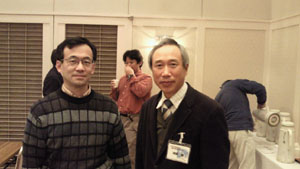
Dr. Osamu
Abe (right) and me.
He also lives in a snowy area and he can seldom comet search in winter
like me. He said he wanted to enjoy comet hinting more after his
retirement. If only we are healthy, we would be active comet hunter as
long as we live!
Friday, March 12
Today
in 2002, I discovered C/2002 E2 Snyder-Murakami. This predawn the sky
was clear and I tried to search the sky in the same way.
I started
searching from Ophiuchus and the first DSO I encountered was NGC6535.
Actually, on the discovery day the first one was NGC6426 followed by
NGC6535, but this time I seemed to begin with more eastern part of the
constellation than in 2002 and NGC6426 did not crossed the FOV.
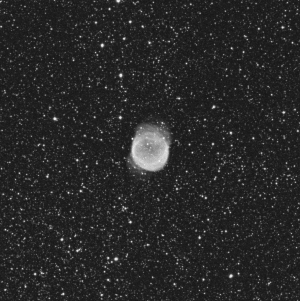
NGC6781
The image is 15f wide. The
Digitized Sky Survey copyright © 1994
Every time
when comet-like objects passed through the FOV, NGC6712, 6760, and 6781
(Planetary nebula), I wondered if they might be a new comet. But
they were DSOs except for one. The exception was C/2009 K5 McNaught that
I have observed a couple of times last month. The comet had a short tail
and looked brighter than in February.
During the
session I stopped comet-searching for a moment and trained my
comet-seeker at C/2009 O2 Catalina at 4:30a.m., because the brightness
the comet had been reported as 10th magnitude but I have not yet
observed it. Contrary to my expectation, I failed to observe the comet.
On Saturday I learned the comet faded abruptly via Japanese comet
mailing list.
Wednesday, February 24
Summer
Milky Way began to rise when I arrived at the observing site. I started
searching from M8 as I completed the comet hunting session near this
object last time at Monday predawn. Soon after the beginning of the
session, M10 came into the FOV. Beautiful! The center of the cluster
resolved into stars that looked transparent: there are a host of stars
at the center but it was not saturated with stars. The stars were just
superposed.
The lower
altitude of the sky was hazy and even 9th magnitude DSO was difficult to
identify using 46 cm comet-seeker. The telescope moved into the Milky
Way. In the constellation of Scutum FOV was filled with hordes of stars.
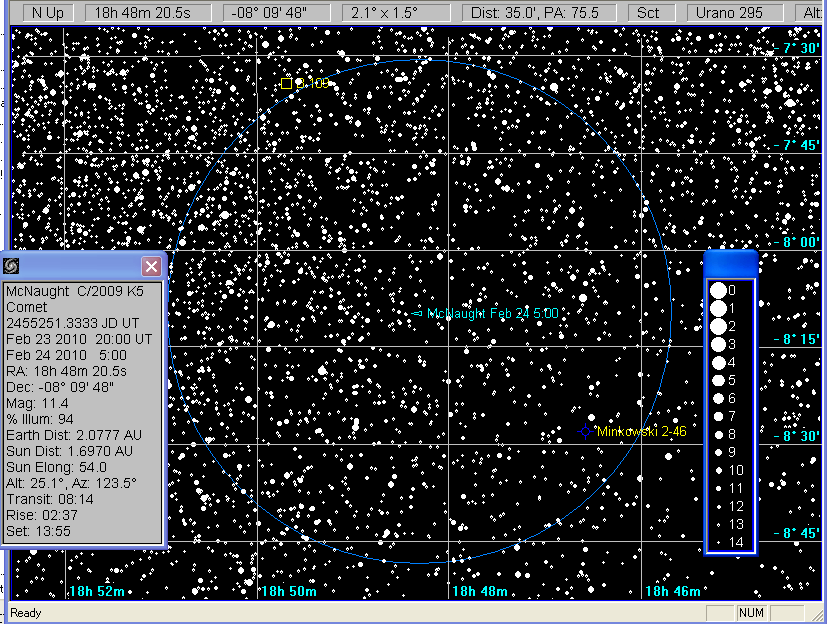
C/2009 K5 McNaught in Scutum
The blue circle represents FOV with 46 cm 68x 1.3 degrees.
(c) MegaStar Ver.5
At 5a.m. during the twilight a globular cluster crossed in the FOV with
the background of vast numbers of stars in Scutum. At the next moment I
noticed it was not the cluster but C/2009 K5 McNaught. I realized the
comet, as I saw M26 during the previous swing of the comet-seeker toward
the horizon two minutes ago. On Monday the comet and M26 were seen in
the same FOV, but this predawn it was between M26 and M11. I checked RA
and RD out for confirmation. The comet looked fainter than on Monday due
to the twilight. It was 10th magnitude. I felt I could have spotted it,
if the magnitude had been darker by 0.5 to 1.0.
Monday, February 8
I saw the crescent
moon has just risen from the eastern horizon when I went out of the
house. I drove some 20 minutes to the observing site.

The eastern
sky at 3:10a.m. The moon was expanded by a factor of four.
The image was drawn by Stellarium.
I assembled
my comet-seeker. I had completed the collimation 15 minutes after
parking my car. As usual, it took additional 10 minutes before starting
the comet hunting session since I had to set up the NGC Max and to put
on a down-filled polar jacket and polar boots.
I introduced
Vega and Antares, with which the moon was visible in the same FOV, to
set up the NGC Max, but the display showed the error message. I noticed
that the installation information of the encoder that usually memorized
in the NGC Max was incorrect, and made a modification. I have
experienced such an incident several times. After the modification,
sitll the NGC Max did not work wellc I had no idea what to do.
I wondered
if I comet searched without the digital setting circles. If I sought the
area where comet-like objects are less, it would be OK. Before I gave up
using the NGC Max, I checked the installation information again. I
realized that the number I input to modify was wrong! I installed -02610
as the number of steps of the encoder instead of -02160. I wasted
approximately 15 minutes.
The
temperature was -7 degrees Celsius with a breeze. My body heat was lost
by the wind but when it was calm I did not feel cold.
Under the
moonlight, I aimed the telescope at M13. The cluster shined modestly, as
the fainter stars were cancelled due to the moonlight. Nevertheless, the
stars in the cluster were well resolved and remained the dignity of the
most beautiful globular cluster in the northern sky. The nearby galaxy
NGC6207 was easily visible.
I began to
search from M13, and after that the first DSO that came into the FOV was
M27. The altitude of the planetary nebula was 10 degrees. M56 and M57
followed it, but M71 seemed to be out of the searching area.
I came
across some wonderful double stars and open clusters during the session.
They all were flickering under the poor seeing. At 5:45a.m. 30 minute
after the start of the twilight, Deneb passed in the FOV, and I
completed the hunting session. Beautiful day break!
Wednesday, January 20
At
last, I could!
This is the fourth predawn I got up in the wee hours to do comet hunting
this year, and the first clear sky. As usual this time of the year, it
has been snowing and the snow depth reached over 3 m in my city.
I woke up at
2a.m. but I did not get out of the bed, because it was too early. I woke
up again at 3a.m., but cloud covered 90% of the sky. I returned to the
bad. At 3:30a.m. the sky was clear with small amount of cloud, and I
decided to comet hunt.
When I
arrived at the site, the amount of the cloud increased as much as 80%.
Most part of the cloud was filmy. Before the start of the comet hunting
session, I observed C/2007 Q3 Siding Spring and 81P/Wild 2 through the
thin cloud. Both of them have short tails but C/2007 Q3 had higher
degree of concentration and looked beautiful.
I comet
searched through the thin cloud, and somewhat frustrated. At long last,
5 minutes before the beginning of the twilight, the sky turned into
clear! Suddenly, Beta Scorpii, a beautiful double star, came into the
FOV. It looked like the two laughing faces. Both the white colored
primary star (mag. 2.6) and the blue secondary (4.9) were scintillating
due to bad seeing. In a second when I moved my comet-seeker downward
away from Bata Scorpii, a sparkling cluster, M4, happened to come into
the FOV. I wonder when I observed this cluster last.
After I
identified M80, two comet-like objects appeared in the FOV. However,
unfortunately, the battery of the NGC Max was dead and I used the map to
confirm the objects. They were exactly M62 and M19 as memorized.
I completed
the session at 5:55a.m. Eventually, it was a satisfactorily session, but
it is forecasted that the coming 6 days will be snowy. When can I enjoy
comet hunting next?

Thursday, January 7
On Christmas
I visited an Australian comet hunter, Richard Brown. He moved to
suburban area recently (it was a rural or a remote area for the Japanese
standards), and is assembling the dome for his 22h reflector mounted on
the equatorial. His dome has not yet completed, but he installed the
reflector in the dome and has a plan to comet hunt with it in a unique
way.
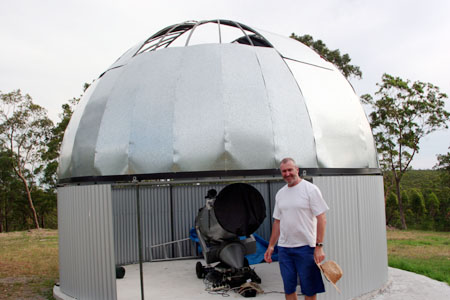
Richard Brown and his 22" equatorial.
The dome is under construction.
Though we
wanted to observe the southern sky with the large aperture, it had been
rainy and cloudy during my stay in his house: not only during my stay
but also almost during the entire period of the trip. He said anyone in
the area could recall such a wet Christmas. The same held true for the
trip to China at the total eclipse last year, that is, I seemed to be a
rainmaker last year.
It was
disappointing that the nasty weather lasted throughout my stay, but we
had a premium time talking about comet hunting, and discovery stories of
the great comet hunters, Honda, Ikeya, and Seki.
He does not
know if he could discover a new comet and I do not either. Having your
goal and dream with passion is primary importance, whatever you do and
wherever you are, because it looks you beautiful. We have exchanged
emails for a few years and I foresaw that he had the same sense with me
before we met, and actually he has. It was as captivating as the
southern sky that I have not observed.
Top of this page